Jerusalem is one of the most deeply contested cities on earth and hasn’t done a great job of living up to its name, meaning ‘City of Peace’. In its long history it has been attacked 52 times, captured and recaptured 44 times, besieged 23 times and destroyed twice (source). Although it is no longer physically divided – with the walls and barbed wire coming down in 1967, boundaries and divisions still exist among its people. How its future will play out with two very different people groups claiming rights to it and three faiths regarding it as sacred, is anyone’s guess.
The future is unknown but the past is well documented… so let’s take a look at the city’s long and complex history that got us to where we are today.
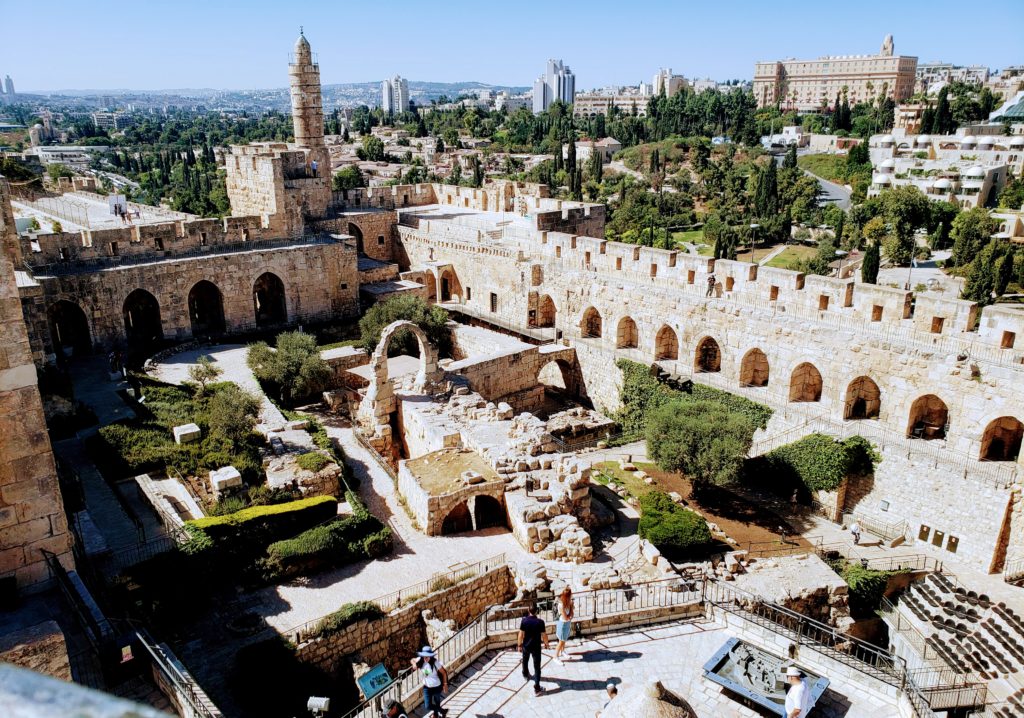
The ‘Tower of David’ not only offers great views of Jerusalem (old and new) but provides a useful historical overview, as in each room of the citadel different periods in the city’s history are explained. I’ve never understood those who claim history is boring – it was always my favourite subject at school. And in this city the history literally comes to life as we can actually see the places – the ruins and buildings (even toilets!) – from millenium gone by. We get to see the ruins of the palace of King David (of David and Goliath fame), touch ancient walls Herod had built and wander through Hezekiah’s 2800 year old tunnels! These experiences on our guided tour of the ancient ‘City of David’ and the information I got from the Tower of David and Israel Museum have helped shape my understanding of the city’s past and provided much content for this post.
Teaching someone else something helps you learn it best so I will attempt to enlighten you my readers about the history of this city and in the process get it clear in my own head! Like the history itself I fear this post may be rather long! Hang in there… 🙂
ca. 2500 – 1006 BCE Canaanite Period
Although wikipedia claims there is evidence of a settlement between 4500- 3500 BCE, the Tower of David info said archaeological findings indicate a settlement existed in Jerusalem about 2500BCE. Either way that is a LONG time ago! City states developed in the land from about 3500 BCE and continued for about 1000 years before a period of decline hit (due to climate change and other factors) which meant a return to a rural and seminomadic way of life. Then at the beginnning of the second millenium BCE a rich urban culture reappeared in the land and fortified city states again dotted the country.
About 2000 BCE the land was called Canaan for the first time in written documents. The first mention of Jerusalem in historic sources is from the 18th century BCE, long before King David chose to make it the capital of the people of Israel ca. 1000BCE.
Settlements of the time were formed near water sources and Jerusalem was no exception. The Gihon Spring lies at the bottom of the hill upon which Jerusalem was built. For security, houses were built higher up which meant the spring lay outside the city’s defenses. Knowing how crucial the water supply was, the Canaanite settlers built a tower with huge stones to protect it and two massive parallel walls providing safe passage down to the Spring (17th century BCE). We went deep underground at the archaeological site, ‘City of David’ and could see the foundations of the tower and remnants of the walls.
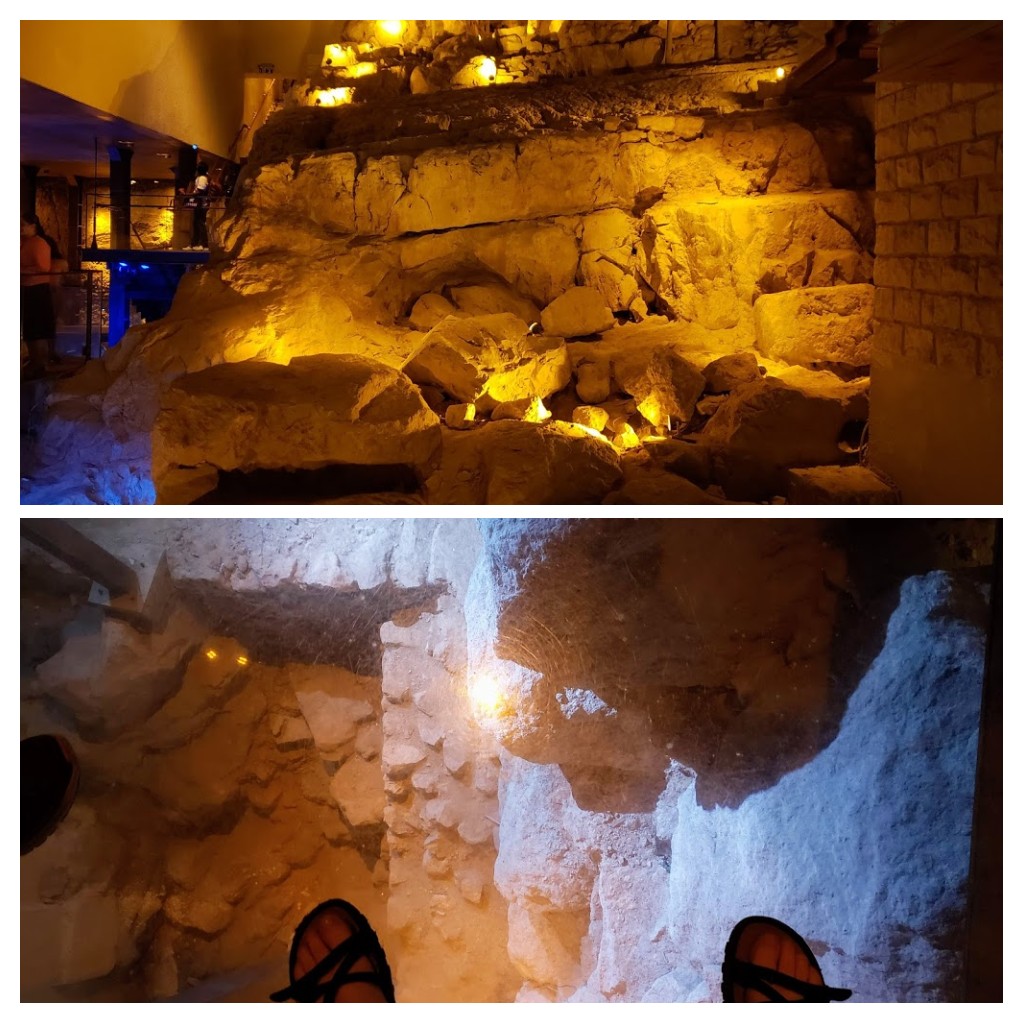
When underground we saw a Canaanite Pool which was created about 1800 BCE. It was filled with waters from the Gihon Spring and used during wartime as a water source for the city when it was under seige. It’s amazing to think that these early inhabitants of Jerusalem managed to quarry an underground tunnel so they had a protected passageway to the water source. The tunnel reached above the spring and water was then drawn with a rope and bucket. This is known as Warren’s Shaft system (after Charles Warren who discovered it in 1867).
About 1000 years later, when the Siloam Tunnel was created (a more sophisticated water system which connected the water source to the city), this pool was filled with earth and simple homes were built on it. The thousands of fish bones and hundreds of bullae (clay seals) that were found in the debris that filled the pool suggest Jerusalem’s early inhabitants enjoyed vibrant trade.
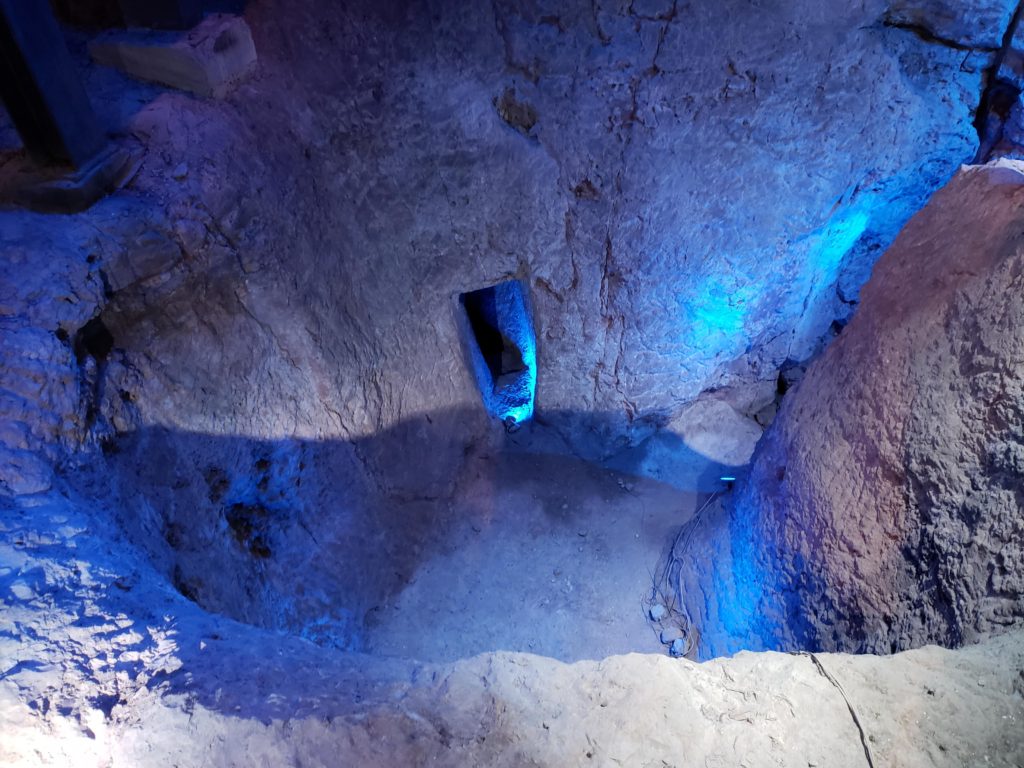
Around 1200 BCE Egyptian rule over Canaan drew to a close and their withdrawal left a tense and unstable situation behind, with many Canaanite cities destroyed. In the northern valleys, Canaanites restored their cities. Meanwhile a new people- the Israelites- appeared in the barren hill country and another group – the Philistines- arrived from Greece or Cyprus and settled in the south. The Israelites and Philistines gradually expanded into Canaanite territory and the various battles fought between them are related in many a biblical story.
Canaanites weren’t a unified group, they had different religious beliefs and many gods. One deity is the storm god Baal who was responsible for fertility and growth. The statue on the left in the picture below is of Baal, it’s a bronze statue from the 15th- 13th century BCE found near Galilee.
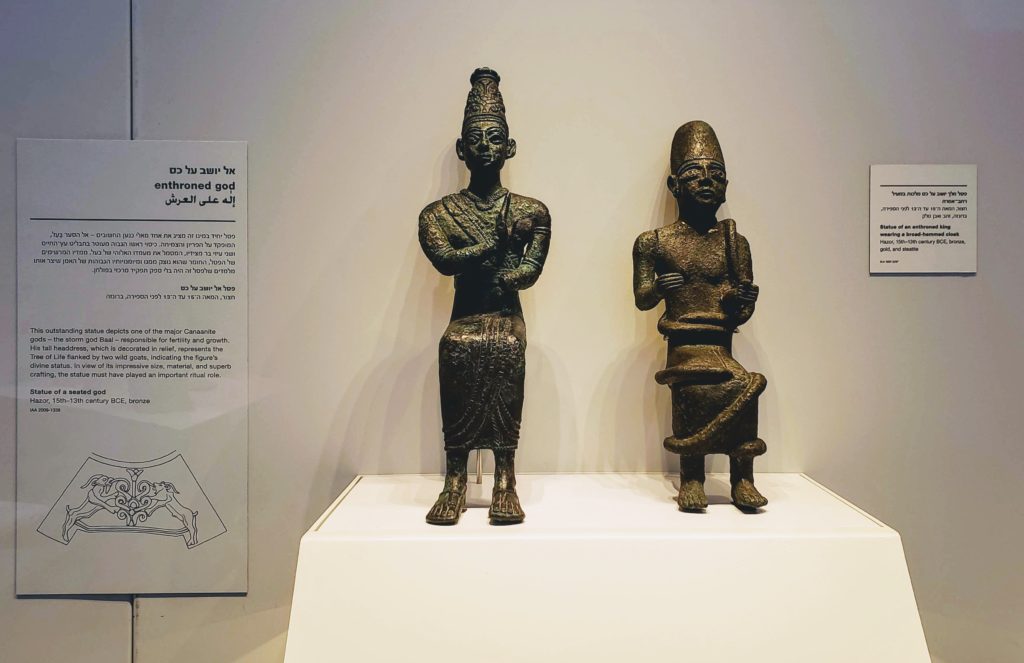
1006 – 586 BCE Israelite Period (First Temple Period)
There was a decline of the great powers in the Ancient Near East and so the Israelites, who began as a loosely organised rural society, over time established a kingdom and made Jerusalem the capital. David conquered the city around 1000 BCE and used Jerusalem as a symbol for a united Israel. That unity didn’t last long though as there were divisions and fights over succession and within about 70 years it divided into the Kingdom of Israel in the North and the Kingdom of Judah in the South. Jerusalem was part of Judah.
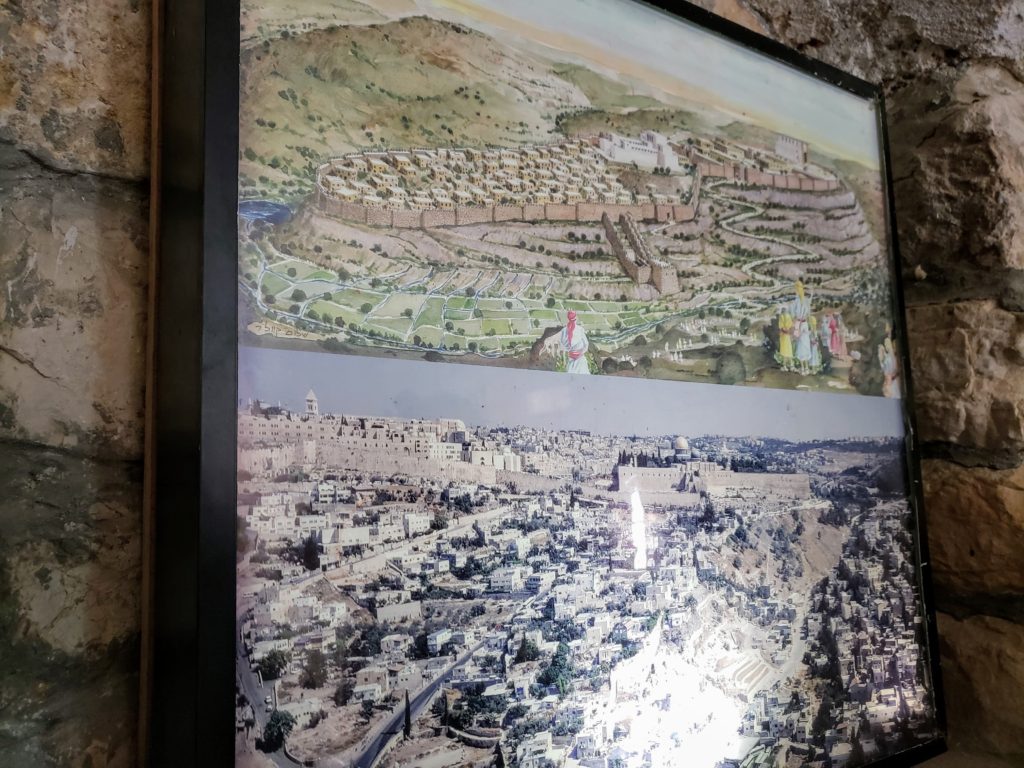
Jerusalem was chosen as a location for a city, not only because of its proximity to the Gihon Spring but also because it is on a hill – with natural fortification in three directions. The ancient city was not where today’s ‘Old City’ is, rather it is just outside it on the eastern slope down to Gihon Spring. Excavations here have unearthed what some archaeologists believe to be the ruins of King David’s palace – at the higher end of the hill along with other houses and artefacts. Much remains undiscovered though, lying deep under today’s predominantly Palestinian Arab neighbourhood of Silwan.
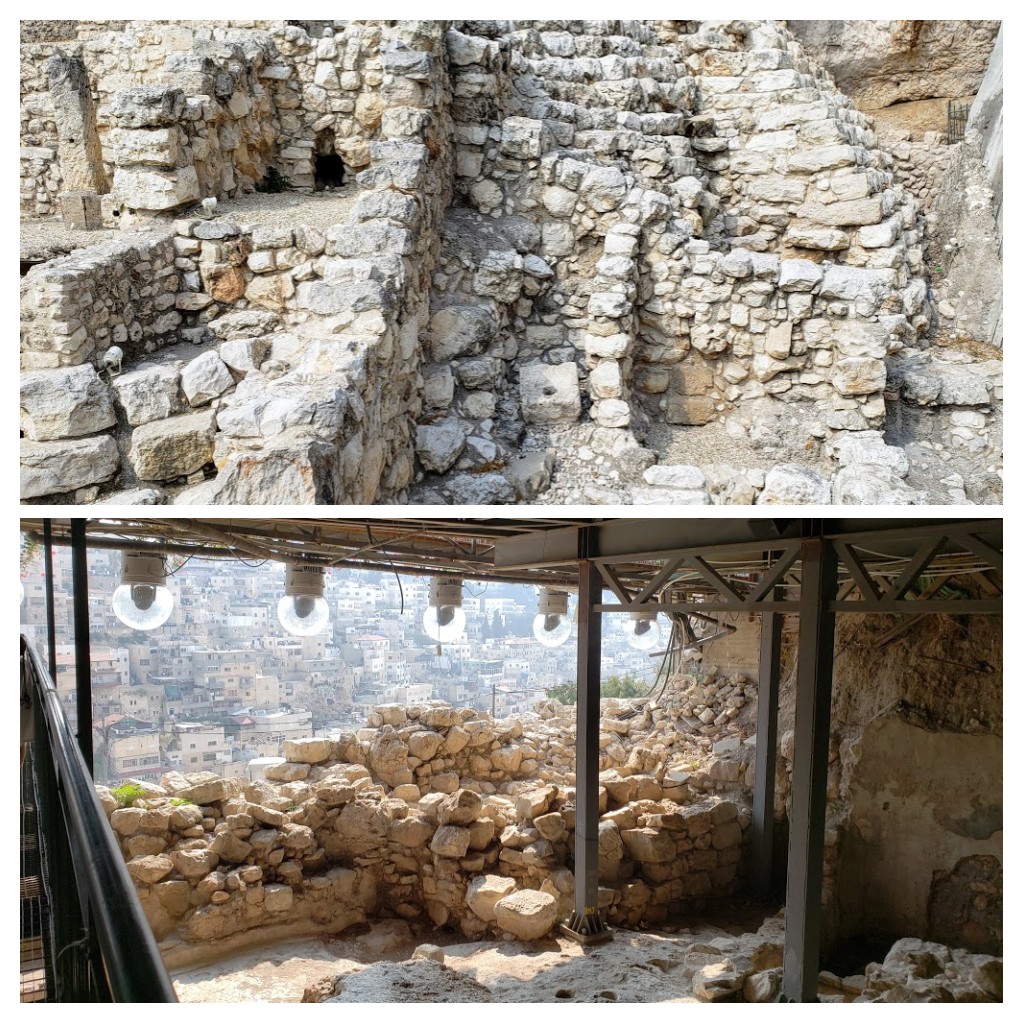
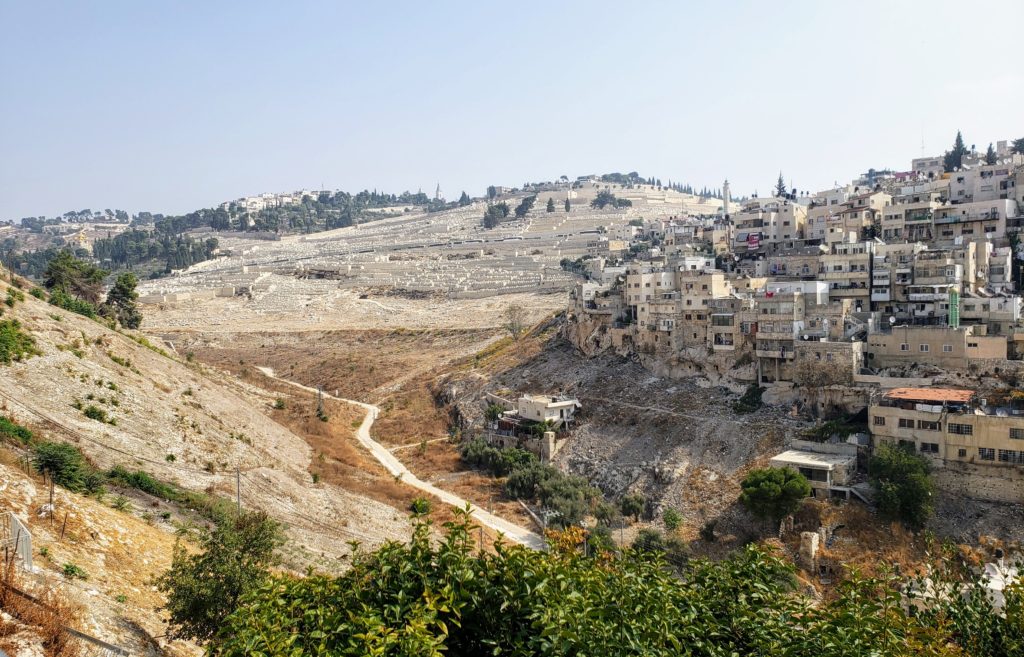
It is not known how Israelites came to worship ONE God, but this process was gradual- still taking place beyond even this period. Although the biblical prophets strongly condemned the polytheistic beliefs of neighbouring nations, their customs and practices informed much of the folk religion that continued to be practised throughout Israel and Judah, with public worship taking place in shrines and sanctuaries, open air sites, near city gates etc. When King David brought the Ark of the Covenant to Jerusalem it made the city a new religious centre for the people of Israel. David designated Solomon (his son) to build the temple which he did in 970 BCE. The temple gained in importance during the 8th and 7th centuries BCE when Kings Hezekiah and Josiah instituted a series of religous reforms that sought to centralise worship of the God of Israel in Jerusalem and abolish foreign practices. Over time the people worshipped fewer gods.
It was about the time of Hezekiah that the Siloam tunnel – aka Hezekiah’s tunnel was built (although some evidence suggests it was made about a century before Hezekiah). It is rather mind boggling that at least 2800 years ago men could quarry through the bedrock, deep in the earth and starting from two different ends manage to meet and connect the tunnel, with just the right gradient. There is a 30cm variation in altitude, which allowed water to flow from the Spring to the Pool of Siloam- incredible! We got to wade through the water, walking the 533m length of the curving tunnel, in awe at what they achieved. There were times when you had to watch your head as it was very low, and a section where it was very high to the roof.
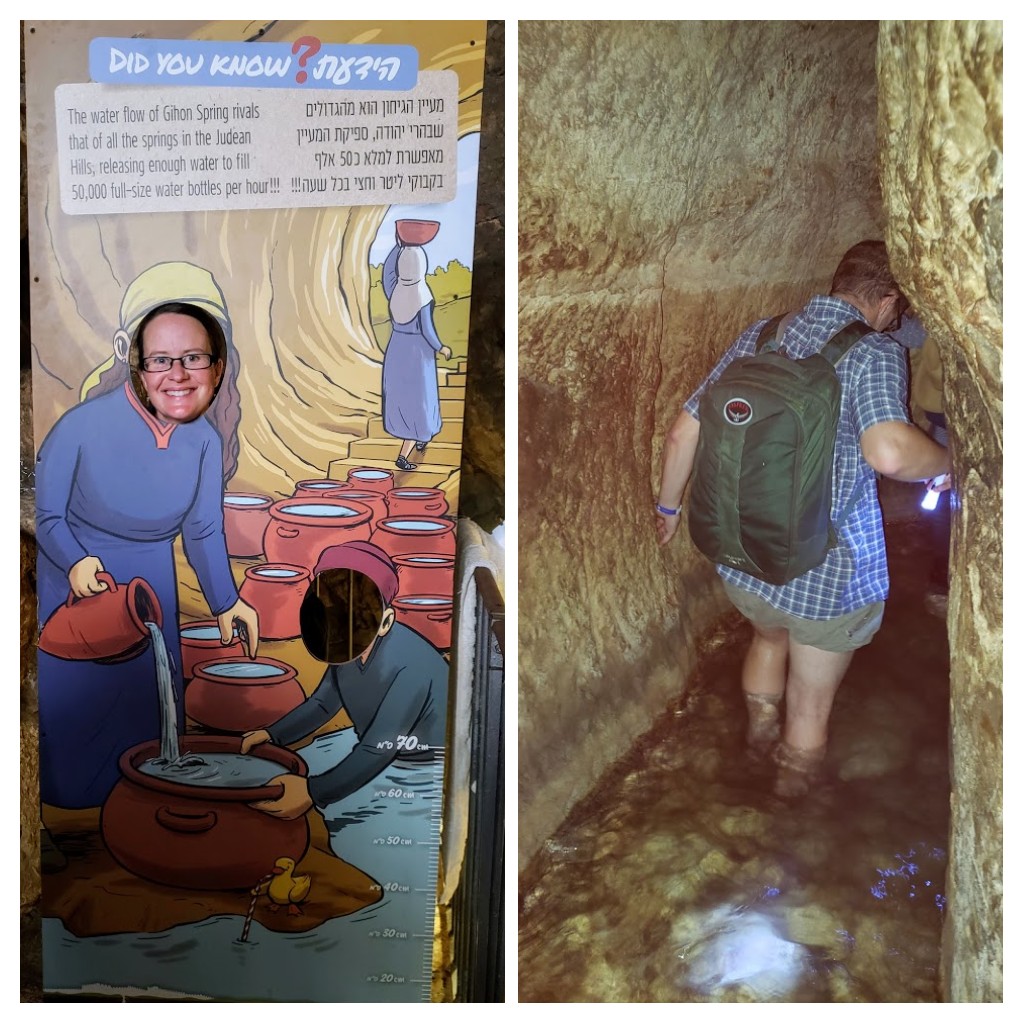
Now as I described under the Canaanite period, there was a tunnel / shaft already in place, along with a tower and massive walls that allowed the city’s inhabitants to access the water safely. So why the need for this new tunnel? Perhaps because the old one released water not used by the city’s residents down into the Kidron Valley, where enemy troops could take advantage of it. With the creation of this additional aqueduct, the entire outflow of the spring could be kept inside the walled area. Surplus water could flow into the Pool of Siloam, thus withholding any water from beseiging forces. Clever huh.
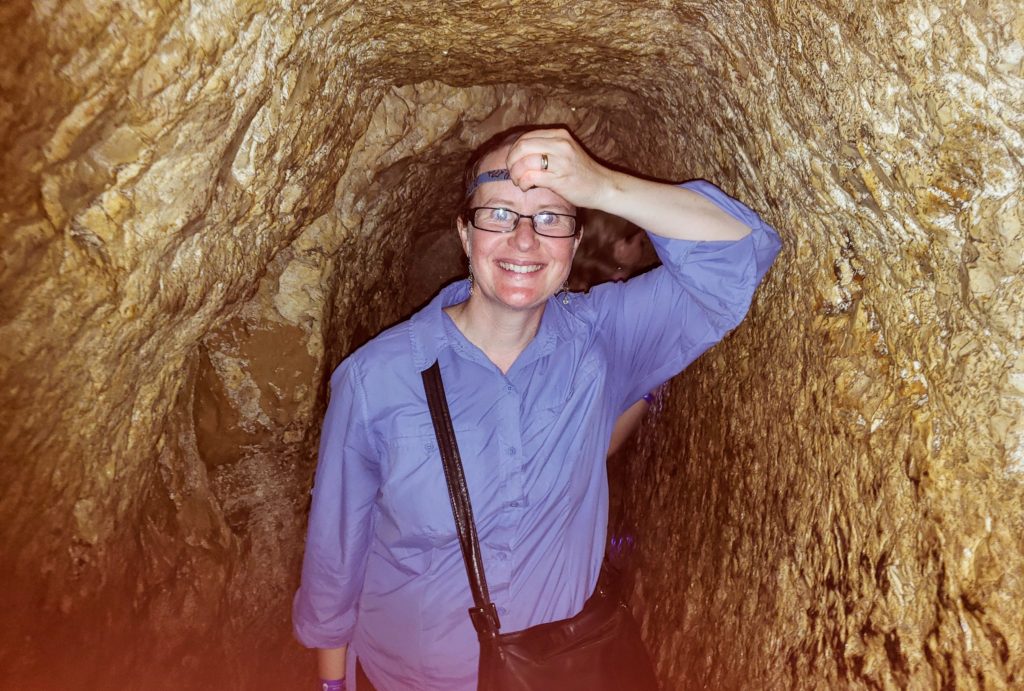
This cunning ploy could not prevent enemies from attacking though. In 722 BCE the Assyrians destroyed the Kingdom of Israel, but Jerusalem (in Judah) remained unnharmed. At the end of the 7th century the Babylonian Empire conquered the Assyrians and then in 586 BCE Nebuchadnezzar, King of Babylonia, sent an army to Judah to subdue Jerusalem. The city and the temple were destroyed and most of the people exiled. Thus ended the Israelite or First Temple period in Jerusalem.
586 – 332 BCE Neo-Babylonian and Persian Period
The Jews were exiled in Babylon from 586 until Babylonia fell to Cyrus King of Persia, in 539. Cyrus succeeded in establishing the largest empire the ancient world had ever seen, extending from India to North Africa. The new ruler allowed religous freedom which meant the exiles could return to Jerusalem, now in the Persian province of Judah, and rebuild their temple. The Second temple was built in 516 and Jerusalem again became the nation’s religous, political and social centre. The Second Temple Period lasted from 516 BCE – 70CE. Here is a model of what the city looked like at that time.

332 – 63 BCE Hellenistic Period
Alexander the Great defeated the Persians in 332 BCE and so began hellenization of the land, i.e. the use of Greek language and adoption of aspects of Greek culture. Greek philosophy and theology influenced Jewish thought and belief in this period. The Hellenistic worldview included freedom of religion so Jews could initially continue worshipping according to their beliefs.
Unfortunately under Antiochus and then his appointed Menelaus, attempts were made to hellenize the Jews. Restrictions were put in place on Judaism (e.g. circumcision and the sabbath were banned) and the temple was desecrated, plundered and then an altar to Zeus was placed in the Temple’s Holy of Holies! This led to the Maccabean (Hasmonean) revolt in the years 166-160 BCE. Hanukkah, the Jewish festival of lights, celebrates this Maccabean Revolt and the narrative that Jewish rebel Judas Maccabeus vanquished the evil Greek emperor Antiochus and rededicated the Temple.
There is an important ‘sub period’ here that follows on from the Maccabean Revolt, called the Hasmonean Period (141- 37 BCE). An indepedent Jewish Kingdom was established where they first had autonomy and then independence under the Hasmonean Monarchy. They refurbished the temple and their Kingdom in Judea expanded until the Romans arrived on the scene.
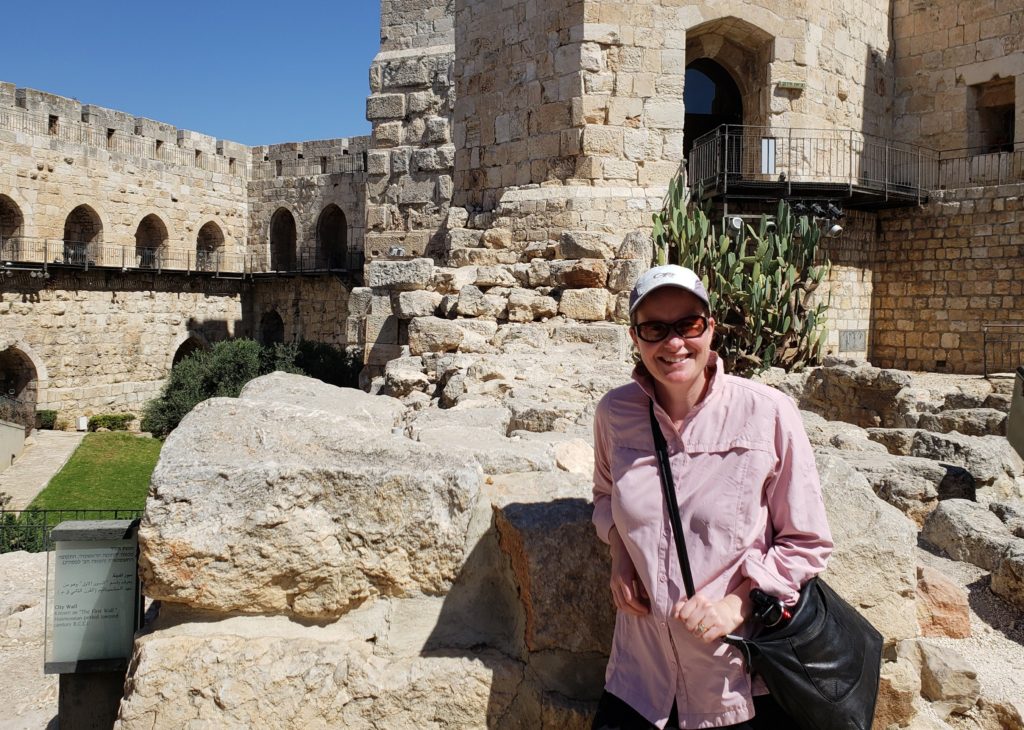

63 BCE – 313 CE Roman Rule
The Romans appeared in Jerusalem in 63 BCE and intially the Jewish kingdom was allowed to continue. The Jews weren’t happy with the new Roman regime however so launched several insurrections against them. The final one under Antigonus saw his defeat and death and with it the end of the Jewish Kingdom/ Hasmonean rule in 40 BCE.
Herod was appointed King of Judea by the Romans in 37 BCE and was granted great autonomy. He used it to launch many building projects, the most signifcant for Jerusalem was the extension of the Temple Mount through the construction of an enormous platform supported by massive walls. Upon the platform he built a spacious plaza with the Temple at the centre, which he also refurbished.
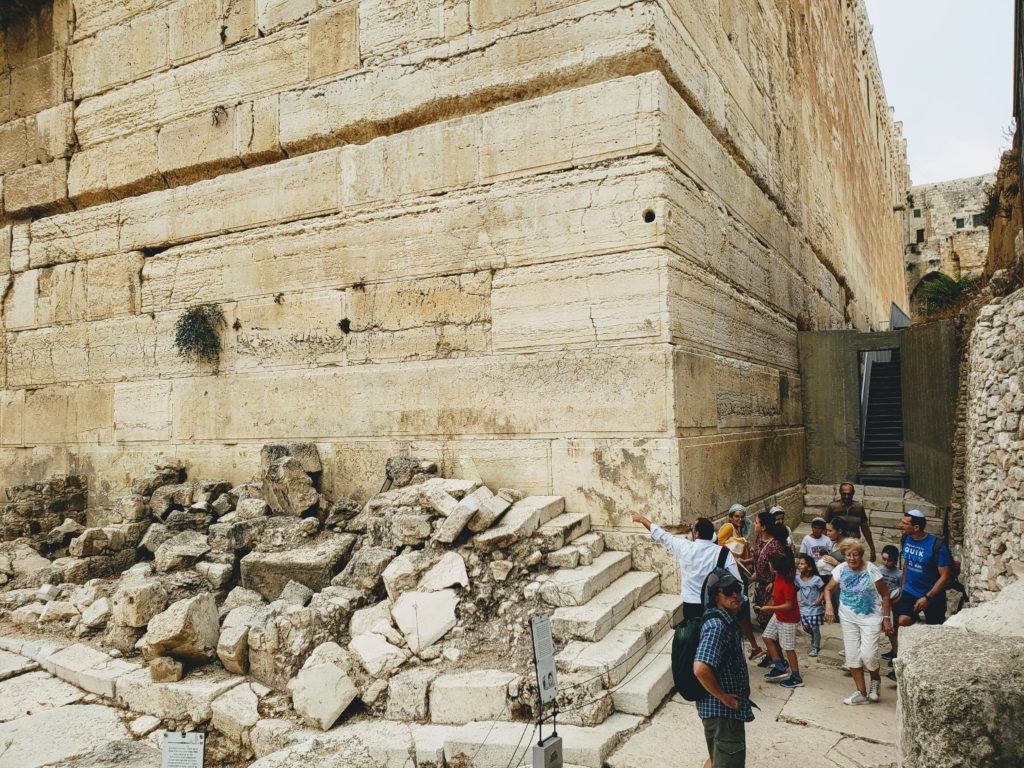
The main thoroughfare of Jerusalem during the second temple period was established in Herod’s time and it had a water drainage tunnel beside it that collected rain water and brought it outside the city. We got to walk through this tunnel heading up the hill, after our walk down through the water channel – pretty cool.
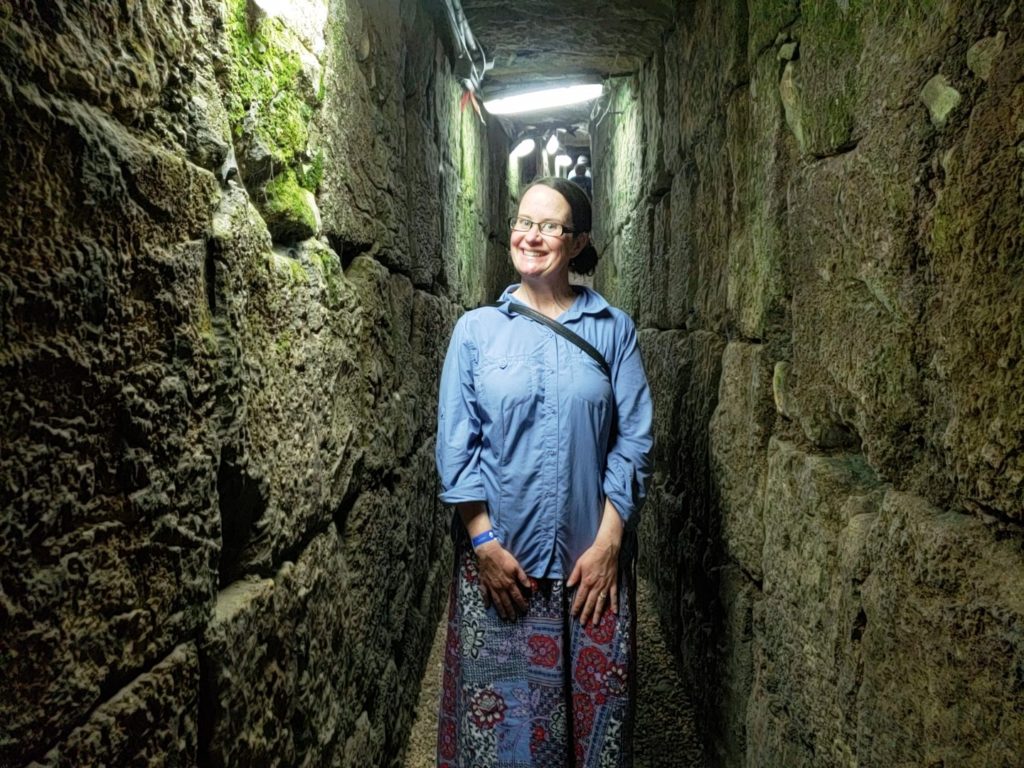
We missed our exit out of this tunnel and ended up popping out at another site in the city, where we could see up close the massive stones used to build the supporting walls, Jerusalem’s main street in the Second Temple period (see photo below) and the shops that opened out onto the street. The rocks you can see piled on the street were thrown down from above by Romans in 70CE during the destruction of the temple above. The buildings on the left of the street were shops. Access to the drainage tunnel we came up out of is the fenced off bit in the middle of the street.
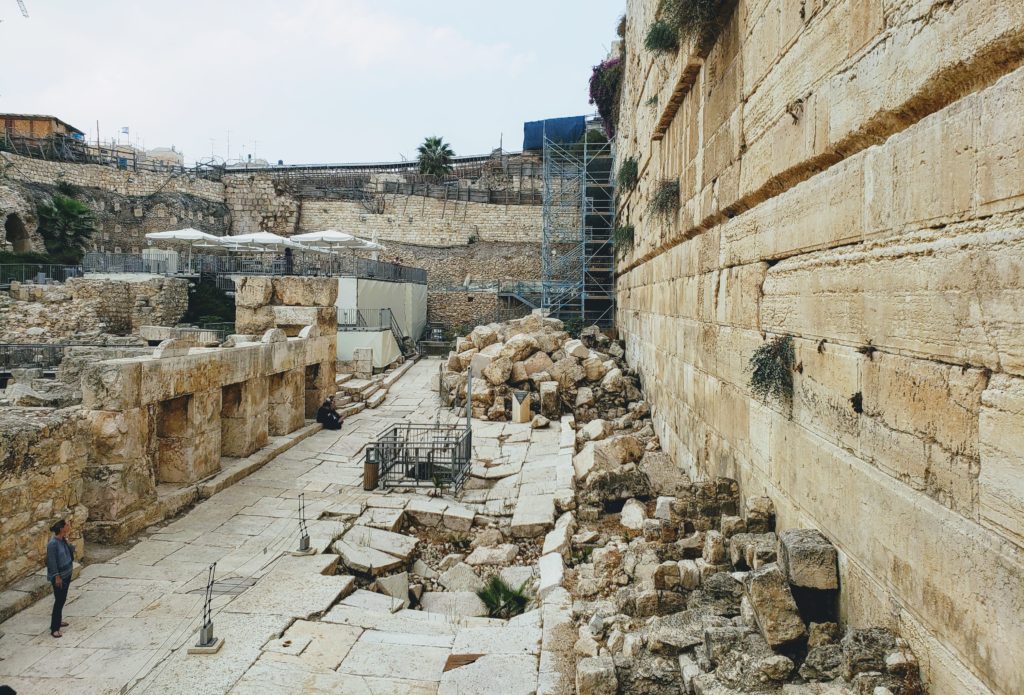
At the Tower of David, you can see below the citadel, the ruins of one of Herod’s palaces. I’ve already written about his incredible winter palace at Masada and we also saw another of his palaces and his tomb near Bethlehem, a place called Herodium. He was a busy guy!
During this Second Temple period, under Roman Rule there were many religious and social tensions in Jewish society. Jesus appears in this context with his activity centered in Galileee, where he taught and preached to the rural Jewish population. In the year 30 CE he went with his disciples to Jerusalem for the festival of Passover. His provocative actions in and around the temple got him into trouble, he was arrested and crucified.
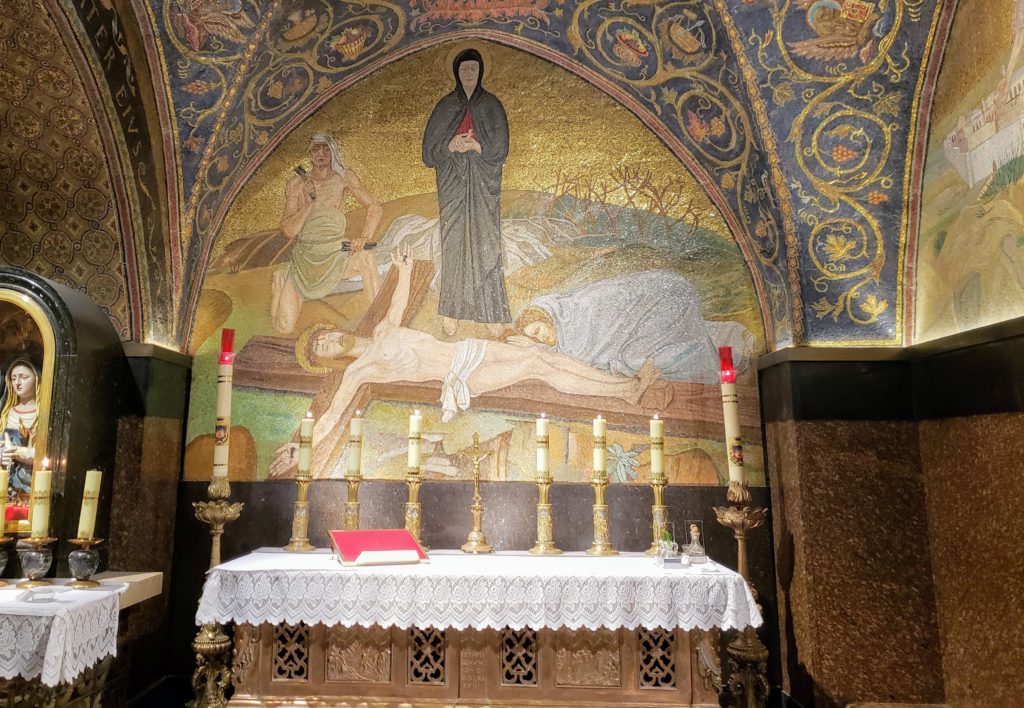
Other key events in this period include the 66 CE Jewish revolt against the Romans and then the devastating response by Rome: the complete destruction of Jerusalem and the Second Temple in 70 CE, under Titus. Another uprising against Rome happened in 132-135 CE but this Bar Kokhba revolt was a complete failure which brought about destruction so great that any chance for Jewish independence was lost. What remained of the city was renamed ‘Aelia Capitolina’.
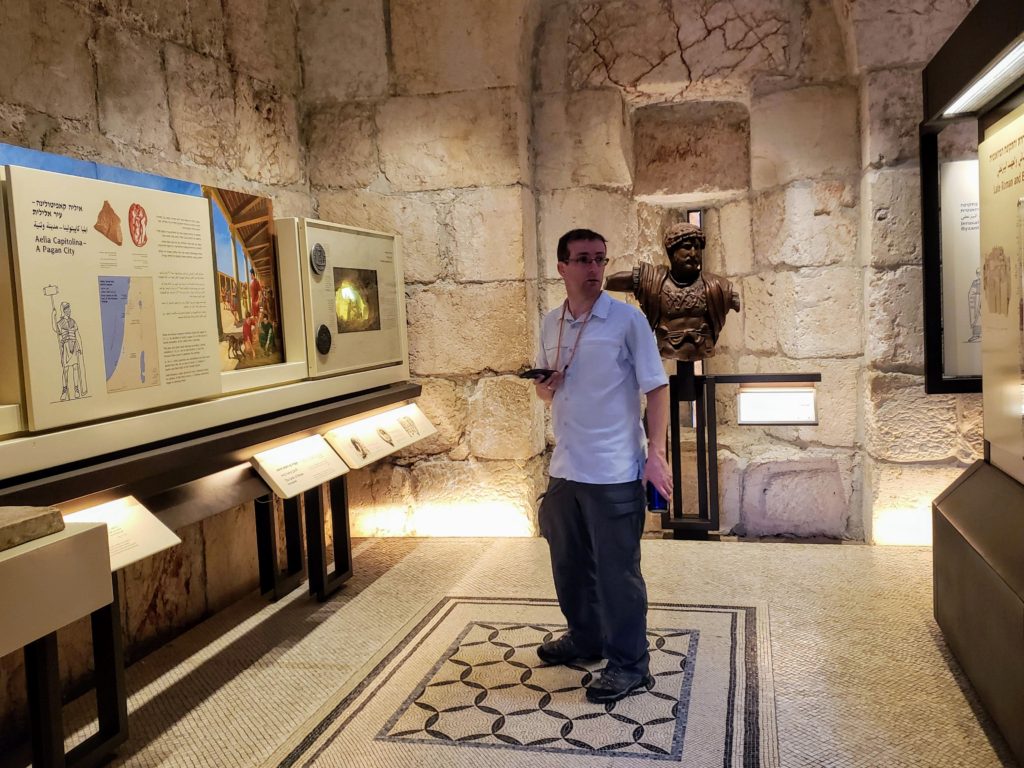
The Romans brought with them to Jerusalem political and technological innovations but also unrest. The end of their rule saw the entrenchment of Christianity in the Empire and the land… which leads us to the next period.
313 – 636 CE Byzantine Period
The 4th century saw a huge change in the once pagan Roman Empire, when the Emperor Constantine recognised Christianity as a tolerated religion. The name, Byzantine Period, comes from the city of Byzantium, where Constantine founded his new capital, Constantinople. In 326 Constantine’s mother, Helena, visited Jerusalem and identified sites associated with Jesus life. She ordered the building of churches including the Church of the Holy Sepulchre – more on that in this post. By the end of the 4th century, Christianity is declared the official religion of the empire and the Land of Israel becomes known as ‘The Holy Land’. This new status meant prosperity, growth and pilgrims, many of whom chose to settle.
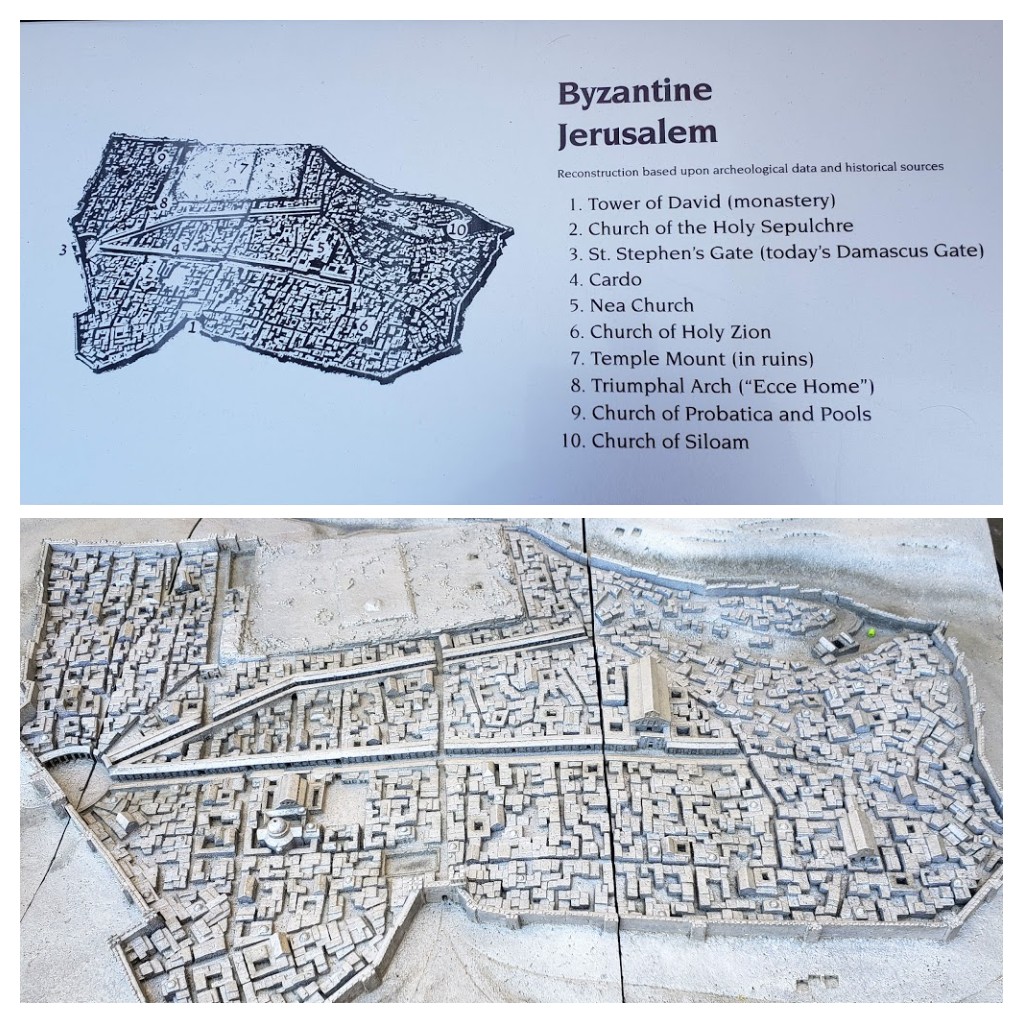
It wasn’t all happy times in the Holy Land though as in 614 the Persians invaded and destroyed Jerusalem’s churches and massacred its inhabitants. Clearly these Persians had different ways of doing things than the tolerant King Cyrus of the past! The Persians were ousted in 629 but then just nine years later another invader arrived on Jerusalem’s doorstep.
636 – 1099 CE Islamic Period
There was virtually no struggle when the Muslims conquered the land. Jerusalem peaceably surrendered. Christians were allowed to practice their faith and Jews were permitted to return.
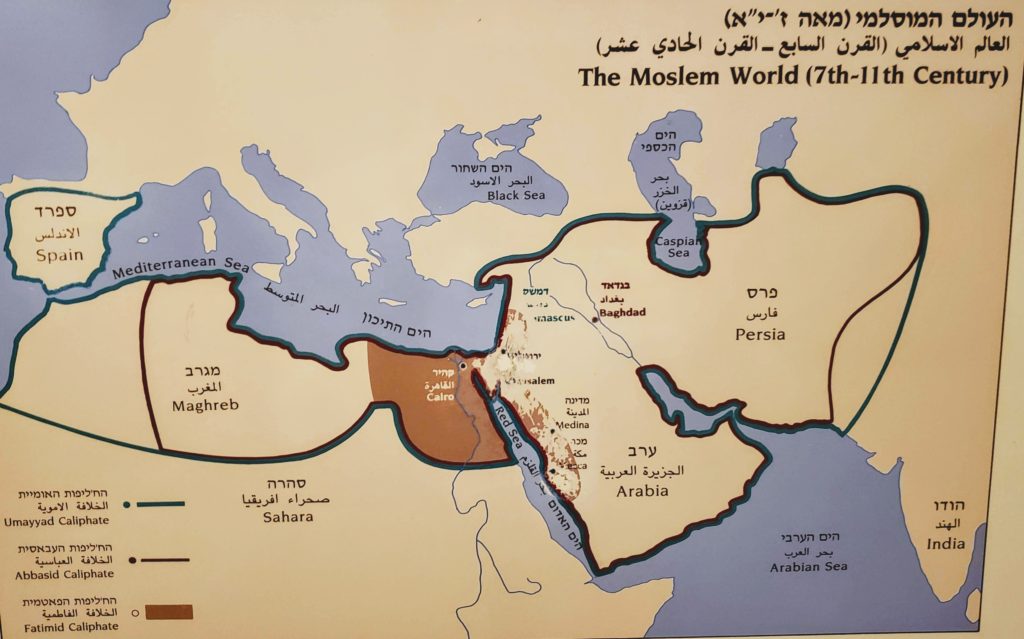
The first Islamic dynasty – the Umayyads – ruled from Damascus until 750. They had the Dome of the Rock built in 691 and transformed Jerusalem into the third most holy city of Islam. More on that in my post here. From 750- 969 the Abbasid dynasty ruled from Baghdad then from 969 – 1099 it was the Fatimid caliphs of Egypt who ruled.
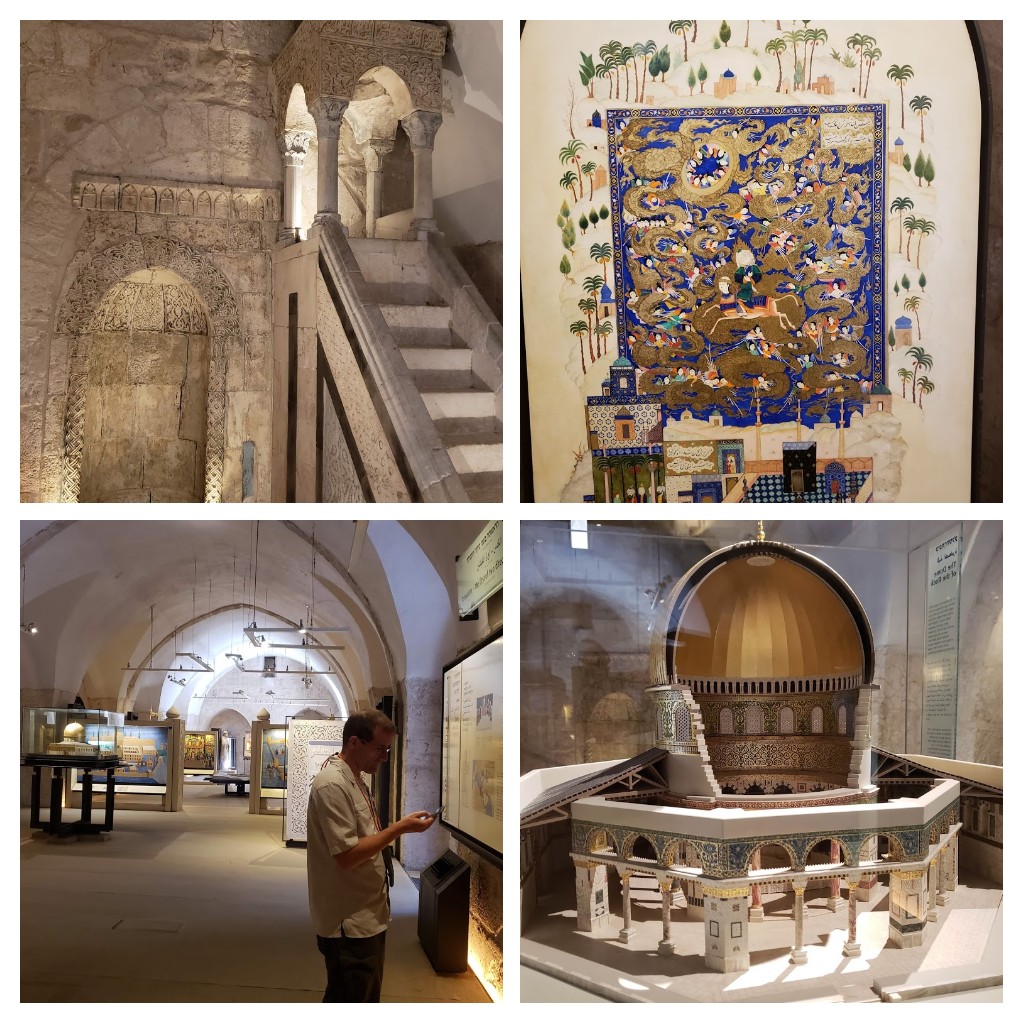
During this Period Islam became the dominant religion in Jerusalem and Arabic the main language. Pilgrims from all three religions came to Jerusalem which gave the city a cosmopolitan feel. During the Fatimid period however Jerusalem lost its importance, neglect set in and there were also uncertain periods for Jews and Christians.
1099 – 1187 Crusader Period
Following an appeal from Pope Urban II to liberate Christian shrines from the Muslims, armies reached Jerusalem from Europe in 1099. The city was conquered after a brief but bitter siege. Muslims and Jews were slaughtered, mosques turned into churches and Jerusalem became a capital city for the first time since the end of Jewish sovereignty a good thousand years before. It was now the capital of the ‘Latin Kingdom of Jerusalem’.
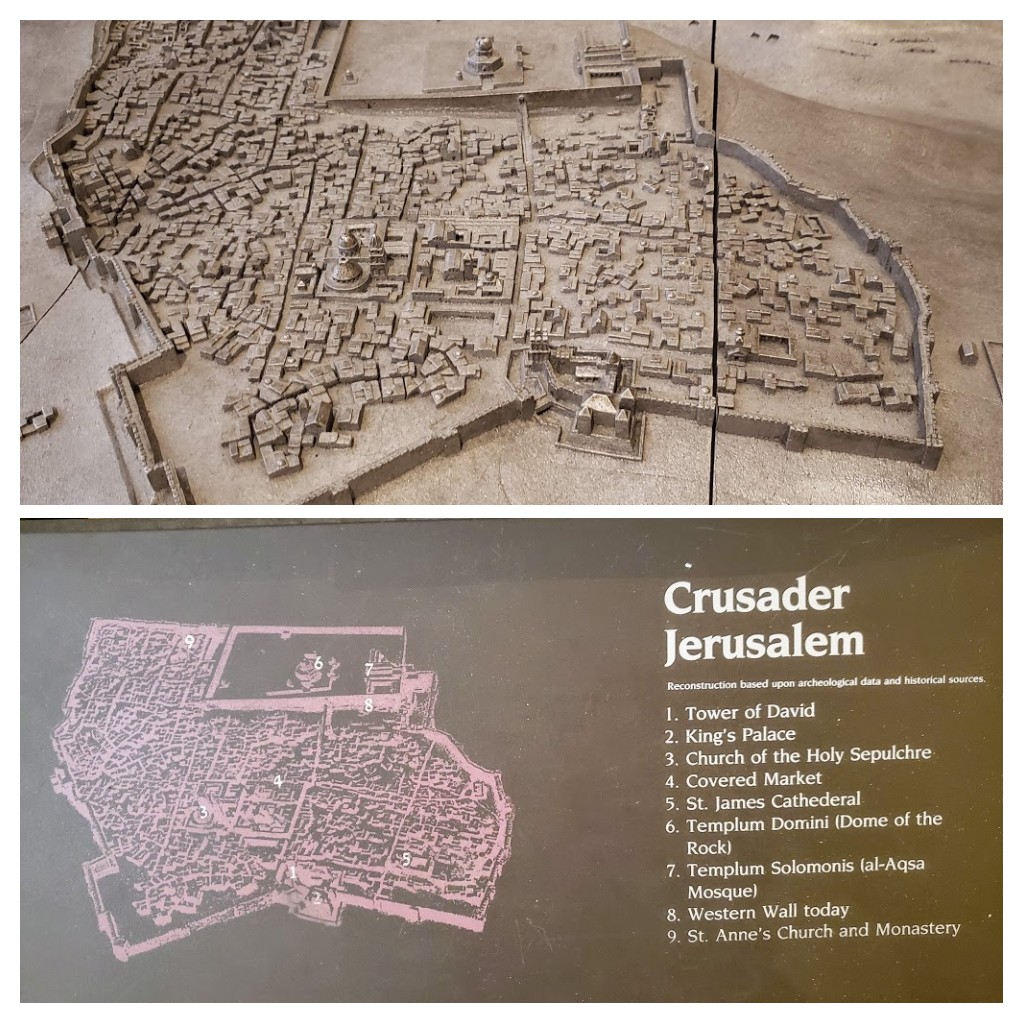
1187 -1229 Ayubid Period
In 1187, the Crusaders lost the city to Saladin, ruler of Egypt and Syria and founder of the Ayyubid Dynasty. The entire crusader population was ransomed, expelled or sold into slavery. Jews returned and settled alongside Muslims and Eastern Christians.
In 1192 Saladain and Richard the Lionhearted signed a peace treaty which assured Christians access to the holy places in Jerusalem. In 1229 Emperor Frederick II negotiatied to divide Jerusalem with the Temple Mount in Muslim hands and the rest of the city under Crusader rule. In 1244 Jerusalem suffered another attack – this time by Turkic tribes from Central Asia. Jews escaped but most of the Christians were killed.
1260 – 1517 Mamluk Period
The city recovered from the attack when it became part of the Mamluk Empire in 1260, but didn’t regain political importance. Its city walls were not fixed. Life in the city centred around the mosques and madrassas as writers and scholars settled here. Jerusalem became a centre for the study of Islam.
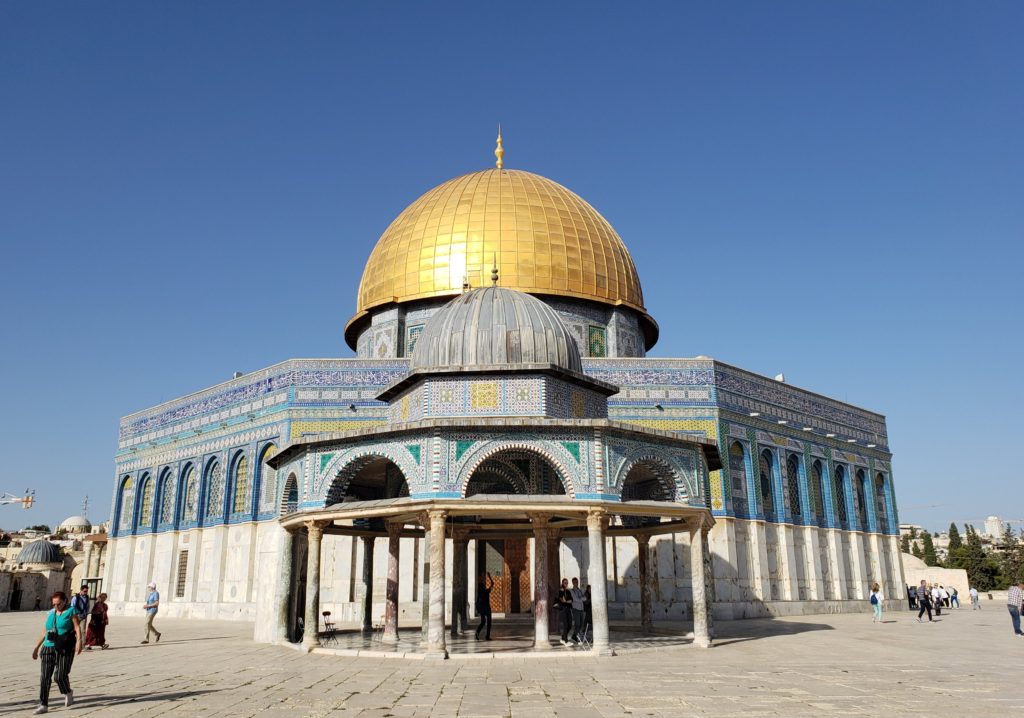
1517 – 1917 Ottoman Period
The Ottoman conquest in 1517 brought about a (short-lived) renewal of the city. Sultan Suleiman ordered a wall built to protect residents from invasion and the citadel (known today as the Tower of David) was restored. The Dome of the Rock was restored with original mosaics replaced by ceramic tiles. Suleiman regulated the water supply and you can see his fountains still around the city.
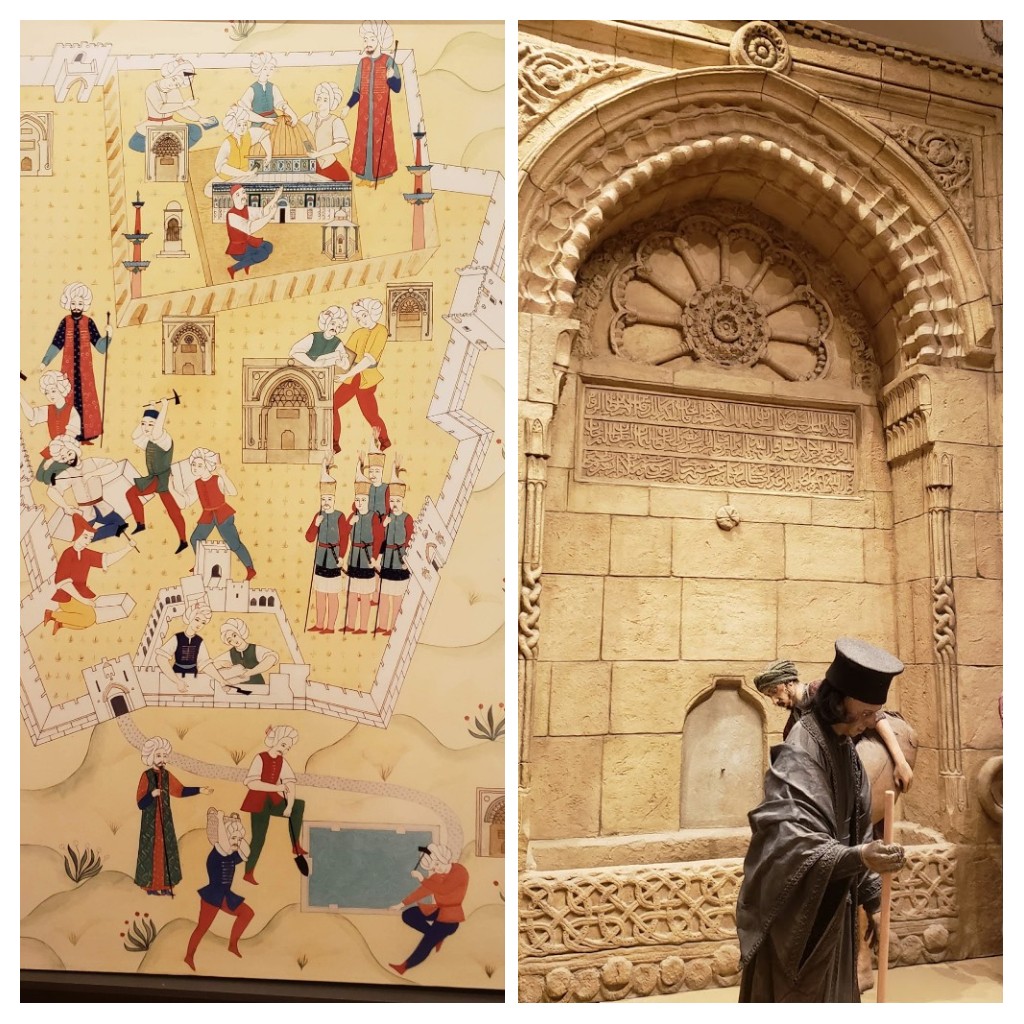
After the initial surge of activity, Jerusalem later fell into neglect as Ottoman Sultans seemed only interested in the city in so far as its holiness to Islam was concerned.
The last 80 years or so of Ottoman Rule things began to change though with East and West meeting in the Holy Land. Jerusalem opened its gates to Europe and modernisation of the city began.
1917 – 1948 British Mandate
On December 9th 1917 Ottoman rule ended in Jerusalem. Two days later General Allenby and his entourage entered the city, proclaiming freedom of worship for all religions. So began 30 years of British rule in Palestine with Jerusalem as its capital.
1948 – contd. State of Israel
In Novemeber 1947 the UN adopted their ‘Partition Plan’, recommending a partition of Mandatory Palestine and the end of the British Mandate. The plan involved the creation of independent Arab and Jewish States with a special international regime for Jerusalem, to be under UN control, not part of either state. The plan hoped to address two competing movements – Palestinian nationalism and Jewish nationalism/ Zionism. The Jewish Agency for Palestine accepted it but the Arab leaders and governments rejected it arguing it violated priniciples of national self-determination.
Civil war broke out immediately after the adoption of this resolution and the plan was never implemented. I wonder what the situation would be like today if the Arab leaders had agreed to the plan. Although not what they wanted, surely the Palestinians would have been better off than they are today. Hmmm…
The Battle for Jerusalem started in December 1947, with Jewish and Arab populations of Palestine (and later Israeli and Jordanian armies) fighting for the control of Jerusalem. The result was a stalemate where Israel captured West Jerusalem and Jordan captured East Jerusalem including the Old City. On April 3 1948 an armistice agreement was signed. May 14 1948 the State of Israel declared its independence.
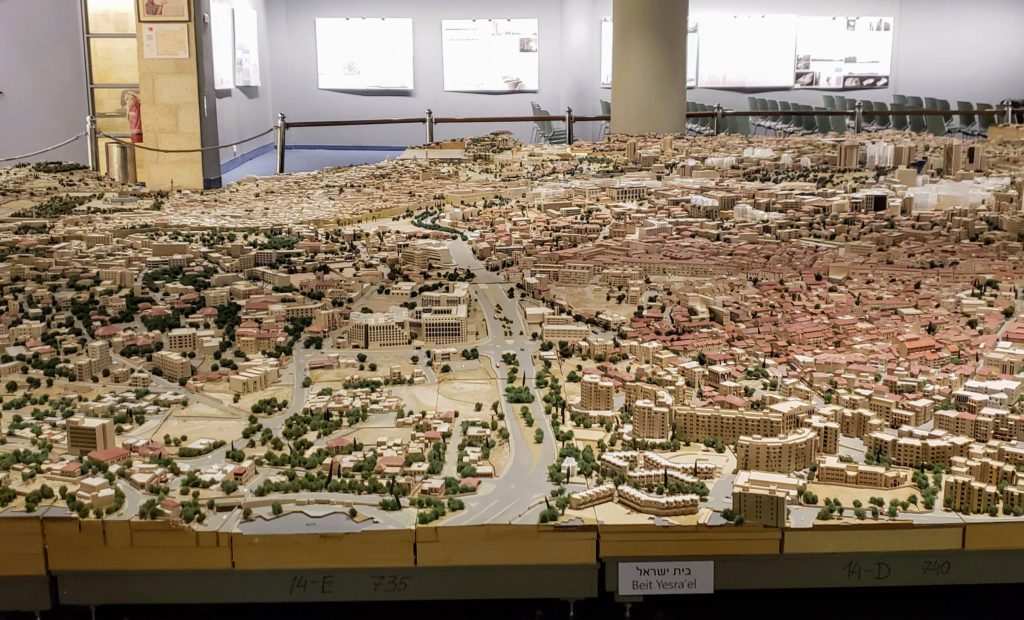
Jordanians immediately expelled all the Jewish residents of East Jerusalem. All but one of the 35 synagogues were destroyed over the course of the next 19 years. Many other historic and religiously significant buildings were replaced by modern structures. The Mount of Olives cemetery was desecrated and tombstones used for construction, paving roads, latrines etc! No wonder Israel sought to reclaim it in 1967.
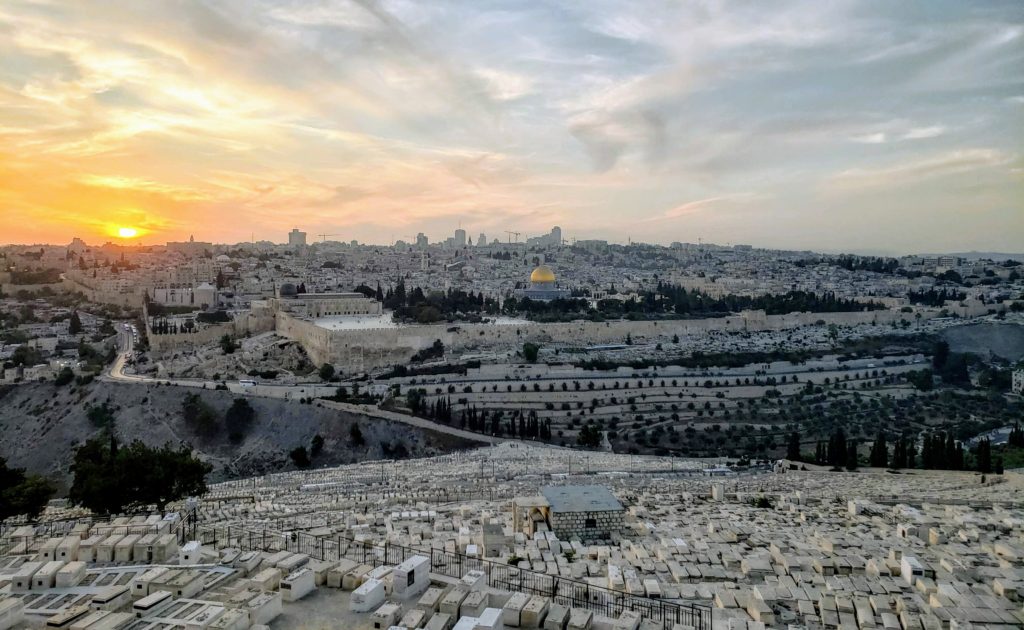
After the 6 day war in 1967 Jordan lost the West Bank to Israel and East Jerusalem came under Israeli control. Jews were able to access the Western Wall again, after 19 years of it being out of reach.
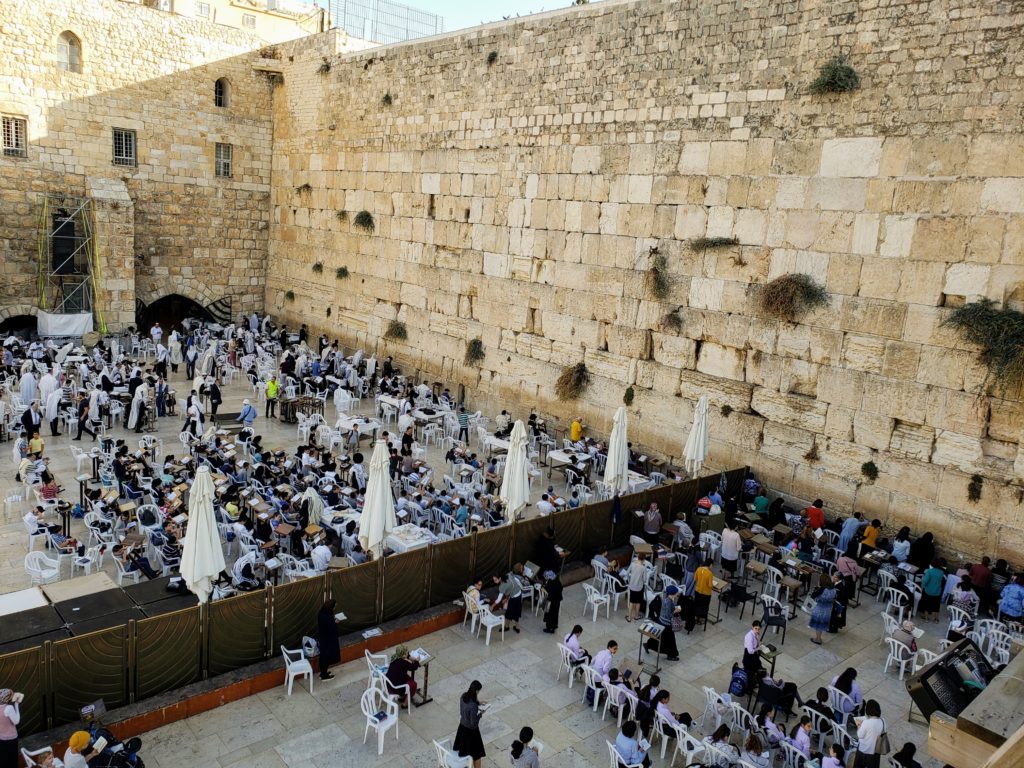
It has not exactly been quiet since 1967 but that is where I will leave the history of Jerusalem for now. Well done if you made it this far!
Hi Kate,
Just had time to read your very interesting blog. I too love history.
A few weeks ago I finished re-reading James Mitchiner’s book ‘The Source’ set not far from Jerusalem. Have you ever read it?
It follows the history behind a number of artefacts found during an archaeological dig – each relevent to the layers of history in this area.
Barbara
Hi Barbara, thanks for the message – pleased you found the post interesting. No I haven’t read that book. We are now in Cyprus – see my facebook page for photos from Antony’s birthday yesterday. Am rather behind in the blog!!